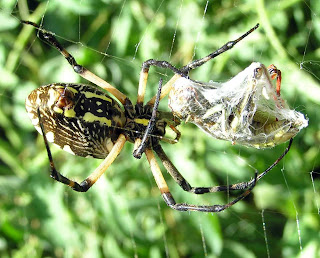 Spring is running a little late this year it seems, but the warming days are making for perfect pre-planting tasks! Venerable ol' Monkey has been closely supervising the building of some new, decorative rocked beds and container arrangements.
Spring is running a little late this year it seems, but the warming days are making for perfect pre-planting tasks! Venerable ol' Monkey has been closely supervising the building of some new, decorative rocked beds and container arrangements.Most of you know that I am into recycling as well as gardening. What better way to indulge myself than combining these two passions into an easy-care container garden?
There are several advantages to container gardening. First off, getting older makes weeding and all that "knee" time a real drag and being able to raise the work area is a delight! As you can see in the arrangement below, old wash tubs and cast off spools are favorites. The whole thing looks pretty ugly right now, but it will be lovely when everything is growing.
 This will be great fun for the grandkids too! They are going to help plant most of it in a few days and will find some neat little treasures as they work. While building the retainer walls, I added crystals, agates and even some toys hidden away in the "caves". There are little platforms and empty caves so they can add their own treasures too.
This will be great fun for the grandkids too! They are going to help plant most of it in a few days and will find some neat little treasures as they work. While building the retainer walls, I added crystals, agates and even some toys hidden away in the "caves". There are little platforms and empty caves so they can add their own treasures too.Many standard garden choices do quite well in containers, including most tomatoes, herbs, garlic, lettuce, squash and more. Container gardening, like raised bed planters, requires a good bit less water to get the same results. You must be sure the "pots" have good drainage, plenty of root space and are placed so they won't get overheated in hot climates.
This area is located in medium shade and the ground area should be good for things like mustard greens and lettuce. These cool loving plants don't do well here in the summer and tend to get bitter and bolt right away. I am hoping the heavier shade and higher humidity will allow them to produce up through July, when they can be replanted for fall and winter.
 Last year I grew patio tomatoes, green beans (pole and bush mixed) and some bell peppers here. There was not enough sun for the bells... they were tiny and the plants never flourished. This year I am going to try an eggplant, chamomile, catnip, cherry tomato, snowpeas and a yellow summer squash along with greens and lettuce.
Last year I grew patio tomatoes, green beans (pole and bush mixed) and some bell peppers here. There was not enough sun for the bells... they were tiny and the plants never flourished. This year I am going to try an eggplant, chamomile, catnip, cherry tomato, snowpeas and a yellow summer squash along with greens and lettuce.This one is going to primarily be for the kiddos anyway and experiments are fun! The regular garden area will get all the old standbys and staples. This year I am getting chickens too... Maybe they can make a dent in the grasshoppers! I also found three of the Golden Orb Weaver egg sacks (see previous post) so my humungoid spiders will probably be around again. They are wonderful on the pests, but I will have to get some shoulder length gloves to keep from being creeped out. lol
I'll post some photos when things get growing so you can see how charming these types of planting areas can be... Until then, Happy Planting!

















